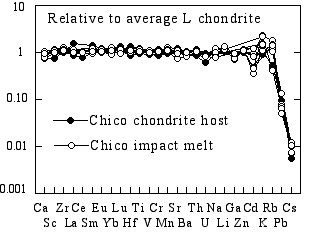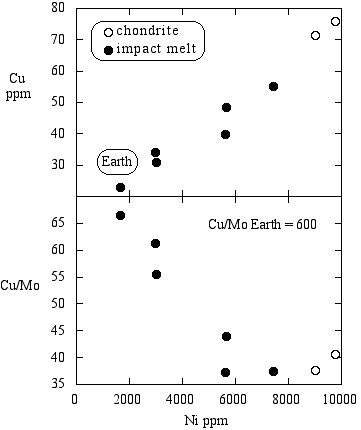VOLATILE AND SIDEROPHILE ELEMENT DEPLETION BY IMPACT PROCESSING OF CHONDRITIC PLANETESIMALS.
Norman, M.D.
GEMOC, Macquarie
Introduction: The L chondrite parent body suffered a massive, possibly catastrophic impact event ~0.5 Ga, producing achondritic impact melt from a chondritic precursor [1]. We are investigating the geochemical consequences of this event in Chico, a 105 kg L chondrite composed of ~60% impact melt intruding host chondrite. The chondrite is shocked to stage S6. The melt is clast-poor, and consists of fine-grained, euhedral olivines, pyroxenes, and interstitial glass. Metallic globules up to 2 cm in diameter are concentrated along the center of the dike, suggesting an early stage of metal-silicate immiscibility.
Chico thus provides a natural laboratory in which to study the behavior of volatile and siderophile elements during impact melting of chondritic planetesimals. Depletion of volatile elements and metal-silicate fractionation are characteristic features of the terrestrial planets, so, conceivably, similar processes on larger scales may have influenced the composition of planetesimals during the early history of the solar system.
Results: Trace element compositions of the impact melt and host chondrite were determined by ICPMS and INAA. Chico experienced a pervasive and extreme depletion of Pb and Cs in both the melt and chondrite host lithologies, relative to average L chondrite (Fig. 1). Refractory and moderately volatile elements are unfractionated, with increasing variability in more volatile elements such as K, Rb, and Cd.
The absolute depletion of Cs in Chico is comparable to that on the Moon,
but the sequence of Pb > Cs in Chico is opposite to that in the Earth and
Moon where Pb may have been more strongly depleted by additional effects
of core formation. The nearly quantitative extraction of Pb (90%) and Cs
(99%) implies an efficient process, perhaps involving a vapor or fluid.

Chico was relatively cold when this impact occurred at 0.5 Ga, but early planetesimals would have been hotter, and efficient impact-induced depletions may have extended to less volatile elements such as K. Mixing of impact-processed chondritic material essentially devoid of volatile lithophiles, with non-depleted components may help to account for the variable abundances of volatile lithophile elements observed in the inner solar system without producing volatility-related isotopic fractionation.
Moderately and highly siderophile elements such as Mo, Cu, Sn, As, Se, Ga, Co, Ni, Ir, and Au are variably depleted in the impact melt relative to the host chondrite (Fig. 2). In the most metal-depleted samples, Ni, Co, Cu, Sn, and Ga reach concentrations similar to Earth's mantle, whereas Mo, As, and Ir are 10x less depleted (Ir = 40 ppb), and Se is 100x less depleted in Chico compared to Earth's mantle. This is unlikely to be simply a volatility effect, given the refractory nature of Ir, and the similar volatilities of Sn and Se. These results imply surprisingly small effective distribution coefficients for at least some of the siderophile elements during metal-silicate fractionation associated with impact melting. Volatile and siderophile element distributions in the Earth's upper mantle may have been controlled at least in part by large impacts into chondritic planetesimals.

 GEMOC ARC National Key Centre
GEMOC ARC National Key Centre